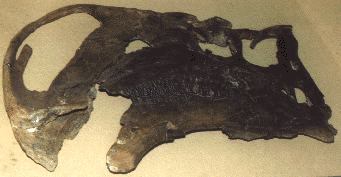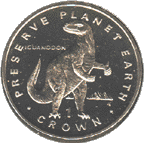
Iguanodon
orientalis -Rozhdestvensky, 1952- skull
Archosauria: Ornithischia: Ornithopoda:
Iguanodontidae
Locality: Dundgov, Gobi Desert, southwestern
Mongolia
Age: Early Cretaceous (Aptian), 120 million years ago
Meaning
of name: "tooth of Iguana"
The
least varied descendants of the fabrosaurid/hypsilophodontids are the
iguanodontid
dinosaurs. They differ from their predecessors
by their larger size and different
proportions. The iguanodontids take their family
name from Iguanodon which was
one of the first dinosaurs described (in 1825).
They were also the first to
be known from an entire skeleton.
First discovered in Europe, skeletons are now
known from North America andAsia.
Iguanodon stood erect on two hind legs, with
three toes on each foot. Its hands had four
fingers and a spike-like thumb,
which it may have used to defend itself. Its teeth are
like of those in hypsilophodonts,
flattened across, and leaf-shaped.
They probably sliced up plant material like
a pair of scissors.
Iguanodon orientalis is very similar to European iguanodonts
except for its large nose.
This hollow structure may have been used as a resonating
chamber for making
mating calls. Because of the large number of skeletons frequently
found
together, paleontologists think they may have formed herds.
Their fossil skeletons
are most often found in sediments deposited in swampy,
lake and river edge environments.
This suggests that is the place they spent most of their
time munching on horsetails,
ferns, cycads and various kinds of conifers.

This
is a $1 dollar coin issued by the government of Liberia.
It is larger than a silver
dollar.





